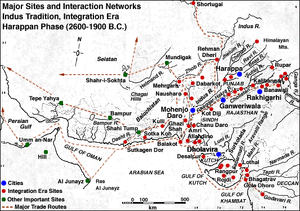Shahr-i-Sokhta
| Author:Laxman Burdak, IFS (R) |

Shahr-e Sūkhté (Persian: شهرِ سوخته, meaning "[The] Burnt City"), also spelled as Shahr-e Sukhteh and Shahr-i Shōkhta, is an archaeological site of a sizable Bronze Age urban settlement, associated with the Jiroft culture. It is a site of Indus Valley Civilization.
Location
It is located in Sistan and Baluchistan Province, the southeastern part of Iran, on the bank of the Helmand River, near the Zahedan-Zabol road. In July 2014 it was placed on the World Heritage List of UNESCO.[1]
Site of Indus Valley Civilization
The reasons for the unexpected rise and fall of the Burnt City are still wrapped in mystery. Artifacts recovered from the city demonstrate a peculiar incongruity with nearby civilizations of the time and it has been speculated that Shahr-e-Sookhteh might ultimately provide concrete evidence of a civilization east of prehistoric Persia that was independent of ancient Mesopotamia.
Covering an area of 151 hectares, Shahr-e Sukhteh was one of the world’s largest cities at the dawn of the urban era. In the western part of the site is a vast graveyard, measuring 25 ha. It contains between 25,000 to 40,000 ancient graves.[2]
The settlement appeared around 3200 BC. The city had four stages of civilization and was burnt down three times before being abandoned in 1800 BC.
| Period | Dating | Settlement size |
|---|---|---|
| I | 3200–2800 BCE | 10–20 ha |
| II | 2800–2500 | 45 ha |
| III | 2500–2300 | 100 ha |
| IV | 2300–2100 |
The site was discovered and investigated by Aurel Stein in the early 1900s.[3][4]
Beginning in 1967, the site was excavated by the Istituto italiano per l'Africa e l'Oriente (IsIAO) team led by Maurizio Tosi. That work continued until 1978. After a gap, work at the site was resumed by the Iranian Cultural Heritage and Tourism Organization team led by SMS Sajjadi.[5] New discoveries are reported from time to time.[6]
Most of the material discovered is dated to the period of c. 2700-2300 BCE. The discoveries indicate that the city was a hub of trading routes that connected Mesopotamia and Iran with the Central Asian and Indian civilizations, and as far away as China.
Shahdad is another related big site that is being excavated. Some 900 Bronze Age sites have been documented in the Sistan Basin, the desert area between Afghanistan and Pakistan.[7]
Helmand and Jiroft cultures: Helmand culture of western Afghanistan was a Bronze Age culture of the 3rd millennium BC. Scholars link it with Shahr-i Sokhta, Mundigak, and Bampur sites.
This civilization flourished between 2500 and 1900 BC, and may have coincided with the great flourishing of the Indus Valley Civilization. This was also the final phase of Periods III and IV of Shahr-i Sokhta, and the last part of Mundigak Period IV.[8]
Thus, Jiroft and Helmand cultures are closely related. Jiroft culture flourished in the eastern Iran, and the Helmand culture in western Afghanistan at the same time. In fact, they may represent the same cultural area. Mehrgarh culture, on the other hand, is far earlier.
Finds: A recent discovery is a unique marble cup, which was found in 29, December 2014.[9]
In January 2015, a Bronze Age piece of leather adorned with drawings was discovered [10]
In December 2006, archaeologists discovered the world's earliest known artificial eyeball.[11] It has a hemispherical form and a diameter of just over 2.5 cm (1 inch). It consists of very light material, probably bitumen paste. The surface of the artificial eye is covered with a thin layer of gold, engraved with a central circle (representing the iris) and gold lines patterned like sun rays. The female remains found with the artificial eye was 1.82 m tall (6 feet), much taller than ordinary women of her time. On both sides of the eye are drilled tiny holes, through which a golden thread could hold the eyeball in place. Since microscopic research has shown that the eye socket showed clear imprints of the golden thread, the eyeball must have been worn during her lifetime. The woman's skeleton has been dated to between 2900 and 2800 BCE.[12]
The oldest known backgammon, dice and caraway seeds, together with numerous metallurgical finds (e.g. slag and crucible pieces), are among the finds which have been unearthed by archaeological excavations from this site.
Other objects found at the site include a human skull which indicates the practice of brain surgery and an earthen goblet depicting what archaeologists consider to be the first animation.
External links
References
- ↑ "Shahr-e Sukhteh", UNESCO website
- ↑ Sandro Salvatori And Massimo Vidale, Shahr-I Sokhta 1975-1978: Central Quarters Excavations: Preliminary Report, Istituto italiano per l'Africa e l'Oriente, 1997, ISBN 978-88-6323-145-8
- ↑ Aurel Stein, Innermost Asia. Detailed Report of explorations in Central Asia, Kansu and Eastern Iran, Clarendon Press, 1928
- ↑ Aurel Stein, An Archaeological Journey in Western Iran, The Geographical Journal, vol. 92, no. 4, pp. 313-342, 1938
- ↑ S. M. S. Sajjadi et al., Excavations at Shahr-i Sokhta. First Preliminary Report on the Excavations of the Graveyard, 1997-2000, Iran, vol. 41, pp. 21-97, 2003
- ↑ Burnt City Broke the Record in Archeological Findings - CHN
- ↑ Andrew Lawler, The World in Between Volume 64 Number 6, November/December 2011 archaeology.org
- ↑ Jarrige, J.-F., Didier, A. & Quivron, G. (2011) Shahr-i Sokhta and the Chronology of the Indo-Iranian Borderlands. Paléorient 37 (2) : 7-34 academia.edu
- ↑ Unique marble cup, other discoveries in Burnt City
- ↑ http://www.newhistorian.com/ancient-piece-leather-found-burnt-city/2718/
- ↑ "3rd Millennium BC Artificial Eyeball Discovered in Burnt City". Cultural Heritage News Agency of Iran. 10 December 2006
- ↑ 5,000-Year-Old Artificial Eye Found on Iran-Afghan Border
Back to Indus Valley Civilisation

